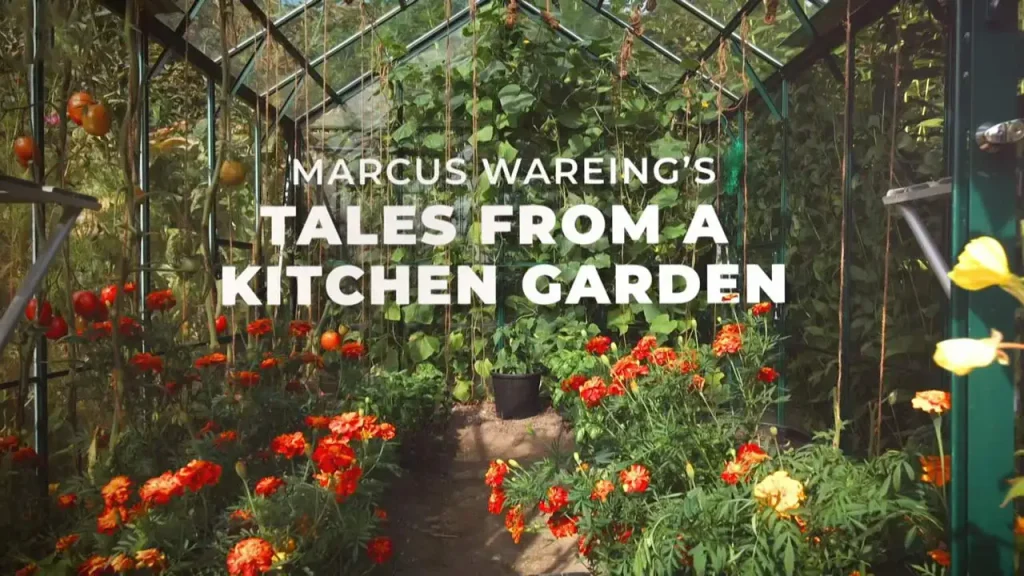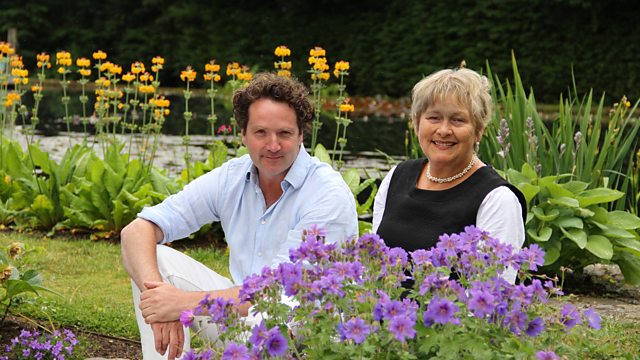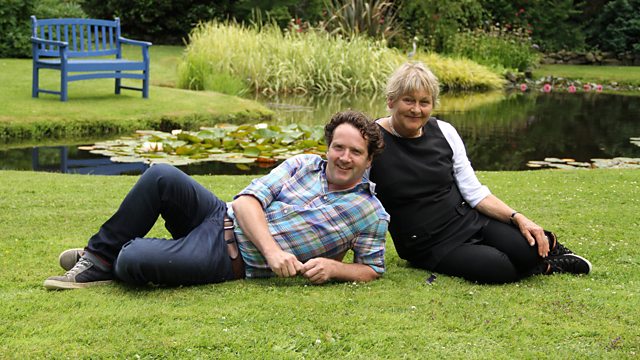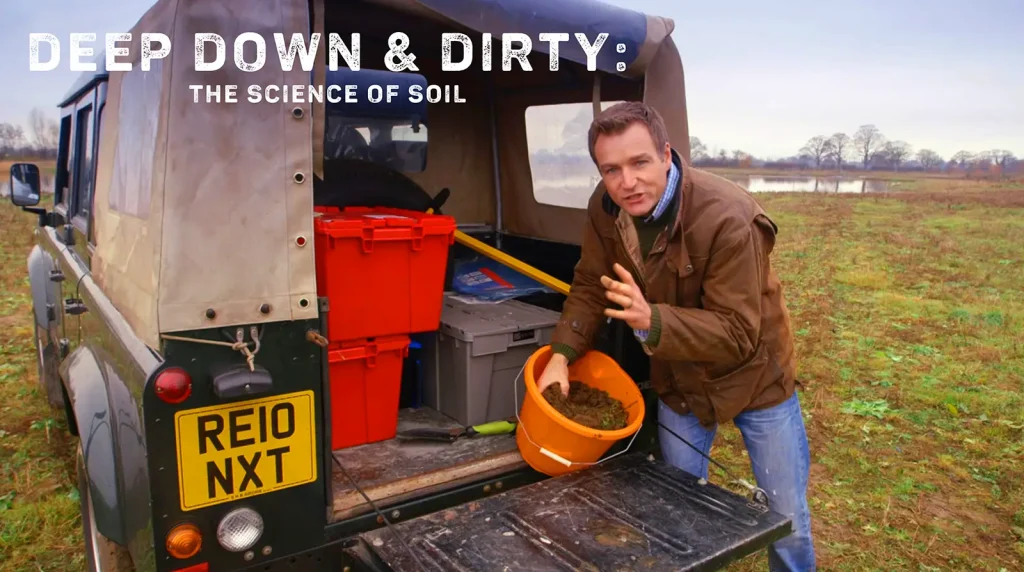Marcus Wareing’s Tales from a Kitchen Garden 2023 Episode 6 – Marcus Wareing, a culinary adventurer, embarks on a quest to expand the horizons of his cooking techniques at his Sussex smallholding. Eager to explore new culinary landscapes, Marcus hatches a plan to construct his very own smoker. Before he can delve into the world of smoked delicacies, however, he realizes he needs the perfect ingredient to christen his forthcoming invention. With this in mind, Marcus sets his sights on a sustainable trout farm located in the scenic Hampshire countryside.
Upon arrival, Marcus becomes engrossed in the intricate details of trout farming, learning the fine nuances that contribute to the fish’s delicate flavor. He gains insights into the responsible methods used, taking note of the farm’s commitment to environmental sustainability. Thrilled with his newfound knowledge, Marcus selects some of the freshest trout and eagerly heads back to his Sussex sanctuary to prepare the fish for its smoky transformation.
Back at his smallholding, Marcus wastes no time. He teams up with Chris Taylor, a fire management expert and long-time friend. Together, they roll up their sleeves and commence building a cold smoker designed for optimum flavor infusion. The project temporarily faces a minor hurdle when Marcus discovers a hole in his shed roof, a result of some mischievous squirrels. Armed with tools, Marcus and Chris pause their culinary endeavor to address this maintenance issue swiftly, ensuring the smoker’s future home is secure.
With the pesky squirrels thwarted and the hole patched, Marcus resumes his culinary project. He skillfully fillets the trout, ensuring each piece is prepared to soak up the smoky flavors to come. Once prepped, Marcus delicately places the trout into the smoker, setting the stage for a gastronomic revelation. The anticipation builds as he waits for the fish to achieve the perfect level of smokiness.
But Marcus is not one to waste time. During the waiting period, he turns his attention to another passion project—a community allotment in north London that’s caught his eye. Toting a freshly bagged batch of compost from his own smallholding, Marcus delivers the much-needed organic material to the community project. Upon his arrival, he meets Paulette, one of the founding members, who gives him a comprehensive tour. Marcus learns about the community’s shared objectives, enriching his understanding of sustainable living even further.
Finally, the moment of truth arrives. Marcus returns to his Sussex haven to find the trout smoked to perfection, infused with an aroma that fills the air. Excitedly, he assembles the finishing touches to an open-faced sandwich masterpiece, adding coal-roasted beetroot for an extra layer of flavor. As he takes the first bite, Marcus relishes not just the taste but the entire journey that led him to this moment. From sourcing sustainable trout to building a smoker and contributing to community sustainability, Marcus experiences a day that goes beyond mere cooking—it’s a celebration of craft, community, and culinary innovation.
Marcus Wareing’s Tales from a Kitchen Garden 2023 Episode 6
The early morning sun peers over the horizon, bathing the scenic Sussex countryside in a warm glow. Marcus Wareing steps out into the crisp morning air, eager to embark on another day of culinary adventures from his quaint countryside abode. As an acclaimed chef and restaurateur constantly seeking new cooking frontiers to explore, Marcus is thrilled to nurture his passions right from his own smallholding.
On this fine spring day, Marcus hatches an ambitious plan – to construct a smoker and delve into the smoky, nuanced world of smoked food. However, he knows that such a cooking contraption demands an exceptional ingredient to christen it. With this in mind, Marcus sets off to source the perfect protein, one worthy of inaugurating his culinary innovation.
An Idyllic Trout Farm Revels in Sustainability
Nestled within the rolling Hampshire hills resides one of England’s premium sustainable trout farms, renowned for its dedication to responsible aquaculture. Upon his arrival, Marcus is warmly welcomed by Charlie, the upbeat farm manager who delights in sharing his wealth of trout knowledge.
As Marcus tours the facilities, he gains captivating insights into the intricate workings of the trout farm. The keen attention to detail is evident, from the purified water flowing through aluminum tanks to the fish feed – an all-natural diet promoting optimal trout health. Marcus also discovers the farm’s impressive commitment to sustainability. The trout are raised responsibly with no antibiotics or hormones. Filter systems are utilized for water conservation while solar panels provide a renewable energy source.
After the enlightening tour, Marcus declares this sustainably-raised trout is the perfect protein to inaugurate his forthcoming smoking contraption. He selects the plumpest, freshest trout fillets, bids the farmers farewell, and heads back to Sussex eager to put his new skills to work.
Building a Smoker – An Assembly of Ingenuity
Back at his countryside abode, Marcus joins forces with his good friend Chris Taylor, a fire management expert, to construct a bespoke cold smoker. The two eager chefs get straight to work, gathering cedar planks and piping to assemble the clever contraption. As they collaborate, Marcus tells Chris of the sustainable trout farm and the fish’s pristine quality. He reiterates his intent for these fillets to be the first to permeate the smoker’s hickory-infused hull.
Things hit a minor snag when the two discover a gaping hole in the smoker’s planned wooden shed housing – courtesy of some bothersome squirrels seeking shelter. Marcus and Chris graciously accept this test to their problem-solving skills. The chefs down tools and swiftly patch the opening with scrap wood, thwarting the sneaky squirrels’ attempts at disruption.
With the hole secure and squirrels evicted, it’s full steam ahead on smoker construction. Marcus meticulously checks the piping angles while Chris affixes the external steel mesh. Before long, their vision morphs into reality, and a completed cold smoker stands testament to their carpentry skills.
Preparing for a Smoky Infusion
Eager to put his new smoking contraption to work, Marcus begins preparing the fresh fillets. He generously seasons each trout fillet with brown sugar, salt, and pepper – a simple rub to complement the forthcoming smoky essence. Marcus then loads the cedar plank with trout meticulously spaced to allow optimal smoke diffusion.
With the fish prepped and loaded, Marcus gently places the cedar plank into the smoker’s hull. As he closes the lid, Marcus smiles with anticipation, eager to sample the trout’s smoky transformation.
While the smoked trout finishes infusing, Marcus opts to pursue another pet project – one of community enrichment. He selects a bushel of ripe compost from his smallholding, packs it into his car, and heads to an emerging community allotment in London that’s captured his attention.
Contributing to a Community – From Compost to Camaraderie
When Marcus arrives at the north London community allotment, he’s warmly greeted by Paulette, one of the project’s founding members. As Paulette gives Marcus a tour of the urban farm, he’s inspired by the initiative and enriched by her knowledge.
The community allotment provides public gardening space for city residents desiring to grow their own organic produce. Marcus learns of the environmental and social benefits. Gardeners compost food scraps to nourish the soil while fostering community bonds by collaborating on allotment projects.
To support their endeavor, Marcus bestows his batch of enriched smallholding compost. Paulette and the gardeners are immensely grateful as quality compost is challenging to source in the city. Marcus leaves the allotment enthused, eager to return and engage with this uplifting sustainability initiative.
A Smoky Culmination – Marcus’ Trout Takes Center Stage
Returning to his countryside abode, Marcus is hit with the tantalizing aroma of smoked trout the moment he enters his kitchen. He rushes to the smoker, peering inside to find the trout fillets infused with a rich amber patina indicative of ideal smoking time.
Unable to resist sampling the fish, Marcus removes a fillet. As he takes his first delicate bite, an explosion of smoky flavor dazzles his palate – the taste transcends all expectations. Marcus beams with contentment, thrilled to have created the optimal conditions for smoked perfection.
For the final touch, Marcus assembles an open-faced sandwich to showcase the trout flavors. He first grills slices of sourdough bread, then delicately places the smoked fillet atop. As a flavorful accent, Marcus adds thin slices of coal-roasted beetroot, intensifying the smoky essence.
With the first bite, Marcus is swept away by the symphony of flavors – the kiss of smoke intermingling with the sweet earthiness of beetroot. This sandwich marks the echelon of Marcus’ smoking endeavors and a glimpse into the limitless creative possibilities before him.
As he reflects on the day’s journey – from sourcing sustainable trout to constructing a smoker to enriching his community – Marcus is overcome with gratitude. Though an acclaimed chef, he relishes that there are always new culinary realms to explore and innovations to pioneer.
Smoked trout, roasted beetroots and watercress on rye

Elevate your culinary game this summer by diving into a weekend project that’s as rewarding as it is delicious: crafting smoked trout from the ground up. This endeavor is far from ordinary—it’s a culinary journey that lets you explore intriguing techniques from salt curing to adding a mouth-watering touch of coal-roasted beetroot. The flavors that emerge are nothing short of extraordinary.
But before you embark on this gourmet adventure, there’s one essential piece of equipment you’ll need—your very own smoker. Investing in a good smoker is not just a purchase; it’s an invitation to unlock a world of flavors and develop new skills in your cooking repertoire. So, if you’re itching to experience the satisfaction of enjoying your own salt-cured, perfectly smoked trout, prepare to take the first step on this exciting culinary path.
Ingredients:
For the cured trout
- 1 trout fillet (or use ready-smoked trout and skip the curing stage)
- 300g/10½oz coarse salt
- 150g/5½oz caster sugar
- 100g/3½oz mixed herbs (i.e. lemon verbena, tarragon, thyme)
- 1 orange, zest only
- 6 small beetroots, scrubbed clean and leaves removed
- 1 lemon, zest and juice only
- 2 tbsp olive oil
- knob of horseradish, grated, plus extra to serve
- 4 slices rye bread
- drizzle of olive oil, to serve
- 50g/1¾oz watercress
- salt and freshly ground black pepper
Method:
- To make the cured trout, mix the salt, sugar, mixed herbs and orange zest together and pack the fillet tightly in the salt mixture in a large, deep tray. Leave to cure for at least 12–24 hours until the flesh and skin starts to toughen. Rinse off the cure and pat dry.
- Place the trout into a smoker for up to 24 hours, or if using ready-smoked trout go to the next step.
- Light the barbecue. When the coals have died down and are no longer flaming, bury the beetroot amongst the coals to cook for up to 1 hour. They will slowly soften and go black and blistered on the skin. Check occasionally and turn if needed. Once softened, peel the skin from the beetroots and chop the flesh.
- In a large bowl, combine the lemon zest, lemon juice, olive oil and grated horseradish. Season with salt and pepper and toss together with the chopped beetroot.
- Drizzle the slices of bread with olive oil, sprinkle with a pinch of salt and toast on the griddle.
- Cut a quarter of the smoked trout and place in a tray over the barbecue to warm through. Once the oils have begun to be released, remove it from the heat and cut into thin slices
- Dress the toasts on a serving platter with the flaked fish, beetroots and a few sprigs of watercress. Grate over some more horseradish and serve.
Key Takeaways
- Responsible agriculture and sustainability should be at the forefront of food sourcing. The trout farm’s eco-friendly practices enriched Marcus’ understanding of ethical food systems.
- Sharing knowledge and collaborating with others can lead to great achievements. Building the smoker with Chris highlighted the power of teamwork.
- Community engagement, whether through sharing compost or volunteering time, is mutually uplifting. Marcus was inspired by the community allotment’s mission.
- Creativity and curiosity are the gateways to culinary revelations. Marcus’ smoker innovation opened up a new realm of flavor possibilities.
- The journey is just as meaningful as the destination. Marcus valued the smoker-building process as much as the trout’s finished flavor.
Frequently Asked Questions
What is Marcus Wareing’s net worth?
Marcus Wareing’s net worth is estimated to be around £5 million. He accrued his wealth through his successful culinary career as a Michelin-starred chef and restaurateur.
What is the best way to farm trout sustainably?
Some best practices for sustainable trout farming include using purified water, avoiding antibiotics and hormones, feeding all-natural diets, monitoring water quality, and utilizing solar energy. The trout farm Marcus visited pioneered eco-friendly aquaculture.
How do you build a cold smoker?
To build a cold smoker, you’ll need materials like cedar planks, piping, steel mesh sheets, and a heat source like charcoal or wood chips. Assembly involves spacing planks for the enclosure, connecting piping for airflow, lining with mesh sheets, and placing a ventilated smoke box.
How do you get rid of squirrels?
Some humane ways to deter squirrels include installing mesh barriers or cap guards to block access, using scent repellents, removing food attractants, and sprinkling cayenne pepper. You can also try trapping and relocating them humanely.
How do I start a community allotment?
Key steps are: Research potential sites, build a volunteer team, create a mission statement, formulate a budget, organize tasks like composting systems, and promote the project to attract participation. Connect with local gardens for guidance.




